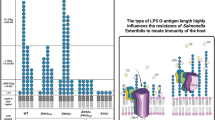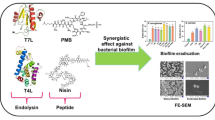Abstract
Staphylococcus aureus is both a component of the normal skin flora and an important pathogen. It expresses a range of recognized and putative virulence factors, such as enterotoxins with superantigenic properties. Several superantigen genes, i.e., seg, sei, selm, seln, and selo, are encoded by the enterotoxin gene cluster (egc), which is found in the majority of S. aureus isolates. Carriage of egc is associated with fitness of S. aureus in the gut microbiota, but it is not known if it contributes to pathogenicity. We constructed egc+ (functional for the seg, selm, and selo genes) and isogenic egc− S. aureus mutants, and investigated their virulence profiles in murine infection models. No effect of egc was seen in a local skin and soft tissue infection model, but in an invasive infection model, increased weight loss was observed after infection with the egc+ as compared to the egc− mutant. Mortality and arthritis were not affected by egc status. Our data suggest that egc has limited effects on the virulence of S. aureus. It may primarily function as a colonization factor increasing commensal fitness, although it might have some aggravating effects on the infection when the bacteria reach the blood.





Similar content being viewed by others
References
Aniansson G, Alm B, Andersson B, Larsson P, Nylén O, Peterson H et al (1992) Nasopharyngeal colonization during the first year of life. J Infect Dis 165(Suppl 1):S38–S42
Lindberg E, Nowrouzian F, Adlerberth I, Wold AE (2000) Long-time persistence of superantigen-producing Staphylococcus aureus strains in the intestinal microflora of healthy infants. Pediatr Res 48:741–747
Lowy FD (1998) Staphylococcus aureus infections. N Engl J Med 339:520–532
Deringer JR, Ely RJ, Stauffacher CV, Bohach GA (1996) Subtype-specific interactions of type C staphylococcal enterotoxins with the T-cell receptor. Mol Microbiol 22:523–534
Dinges MM, Orwin PM, Schlievert PM (2000) Exotoxins of Staphylococcus aureus. Clin Microbiol Rev 13:16–34
Lina G, Bohach GA, Nair SP, Hiramatsu K, Jouvin-Marche E, Mariuzza R; International Nomenclature Committee for Staphylococcal Superantigens (2004) Standard nomenclature for the superantigens expressed by Staphylococcus. J Infect Dis 189:2334–2336
Jarraud S, Peyrat MA, Lim A, Tristan A, Bes M, Mougel C et al (2001) egc, a highly prevalent operon of enterotoxin gene, forms a putative nursery of superantigens in Staphylococcus aureus. J Immunol 166:669–677
Cretenet M, Even S, Le Loir Y (2011) Unveiling Staphylococcus aureus enterotoxin production in dairy products: a review of recent advances to face new challenges. Dairy Sci Technol 91:127–150
Blaiotta G, Fusco V, von Eiff C, Villani F, Becker K (2006) Biotyping of enterotoxigenic Staphylococcus aureus by enterotoxin gene cluster (egc) polymorphism and spa typing analyses. Appl Environ Microbiol 72:6117–6123
Becker K, Friedrich AW, Peters G, von Eiff C (2004) Systematic survey on the prevalence of genes coding for staphylococcal enterotoxins SElM, SElO, and SElN. Mol Nutr Food Res 48:488–495
Nowrouzian FL, Dauwalder O, Meugnier H, Bes M, Etienne J, Vandenesch F et al (2011) Adhesin and superantigen genes and the capacity of Staphylococcus aureus to colonize the infantile gut. J Infect Dis 204:714–721
Ferry T, Thomas D, Genestier AL, Bes M, Lina G, Vandenesch F et al (2005) Comparative prevalence of superantigen genes in Staphylococcus aureus isolates causing sepsis with and without septic shock. Clin Infect Dis 41:771–777
Baba T, Bae T, Schneewind O, Takeuchi F, Hiramatsu K (2008) Genome sequence of Staphylococcus aureus strain Newman and comparative analysis of staphylococcal genomes: polymorphism and evolution of two major pathogenicity islands. J Bacteriol 190:300–310
Luong TT, Lee CY (2007) Improved single-copy integration vectors for Staphylococcus aureus. J Microbiol Methods 70:186–190
Holden MT, Feil EJ, Lindsay JA, Peacock SJ, Day NP, Enright MC et al (2004) Complete genomes of two clinical Staphylococcus aureus strains: evidence for the rapid evolution of virulence and drug resistance. Proc Natl Acad Sci U S A 101:9786–9791
Collery MM, Smyth DS, Tumilty JJ, Twohig JM, Smyth CJ (2009) Associations between enterotoxin gene cluster types egc1, egc2 and egc3, agr types, enterotoxin and enterotoxin-like gene profiles, and molecular typing characteristics of human nasal carriage and animal isolates of Staphylococcus aureus. J Med Microbiol 58:13–25
Williams P, Ketley J, Salmond G (eds) (1998) Bacterial pathogenesis, vol 27. Academic Press, San Diego
Derzelle S, Dilasser F, Duquenne M, Deperrois V (2009) Differential temporal expression of the staphylococcal enterotoxins genes during cell growth. Food Microbiol 26:896–904
Nowrouzian FL, Monstein HJ, Wold AE, Adlerberth I (2005) Effect of human milk on type 1 and P-fimbrial mRNA expression in intestinal Escherichia coli strains. Lett Appl Microbiol 40:74–80
Lee YD, Moon BY, Park JH, Chang HI, Kim WJ (2007) Expression of enterotoxin genes in Staphylococcus aureus isolates based on mRNA analysis. J Microbiol Biotechnol 17:461–467
Lina G, Cozon G, Ferrandiz J, Greenland T, Vandenesch F, Etienne J (1998) Detection of staphylococcal superantigenic toxins by a CD69-specific cytofluorimetric assay measuring T-cell activation. J Clin Microbiol 36:1042–1045
Tseng CW, Zhang S, Stewart GC (2004) Accessory gene regulator control of staphyloccoccal enterotoxin d gene expression. J Bacteriol 186:1793–1801
Kwiecinski J, Jin T, Josefsson E (2014) Surface proteins of Staphylococcus aureus play an important role in experimental skin infection. APMIS 122:1240–1250
Bremell T, Lange S, Yacoub A, Rydén C, Tarkowski A (1991) Experimental Staphylococcus aureus arthritis in mice. Infect Immun 59:2615–2623
Josefsson E, Higgins J, Foster TJ, Tarkowski A (2008) Fibrinogen binding sites P336 and Y338 of clumping factor A are crucial for Staphylococcus aureus virulence. PLoS One 3:e2206
van Belkum A (2006) Staphylococcal colonization and infection: homeostasis versus disbalance of human (innate) immunity and bacterial virulence. Curr Opin Infect Dis 19:339–344
Karauzum H, Ferry T, de Bentzmann S, Lina G, Bes M, Vandenesch F et al (2008) Comparison of adhesion and virulence of two predominant hospital-acquired methicillin-resistant Staphylococcus aureus clones and clonal methicillin-susceptible S. aureus isolates. Infect Immun 76:5133–5138
Holtfreter S, Grumann D, Schmudde M, Nguyen HT, Eichler P, Strommenger B et al (2007) Clonal distribution of superantigen genes in clinical Staphylococcus aureus isolates. J Clin Microbiol 45:2669–2680
Abdelnour A, Bremell T, Tarkowski A (1994) Toxic shock syndrome toxin 1 contributes to the arthritogenicity of Staphylococcus aureus. J Infect Dis 170:94–99
Abdelnour A, Bremell T, Holmdahl R, Tarkowski A (1994) Clonal expansion of T lymphocytes causes arthritis and mortality in mice infected with toxic shock syndrome toxin-1-producing staphylococci. Eur J Immunol 24:1161–1166
Zhao YX, Abdelnour A, Kalland T, Tarkowski A (1995) Overexpression of the T-cell receptor V beta 3 in transgenic mice increases mortality during infection by enterotoxin A-producing Staphylococcus aureus. Infect Immun 63:4463–4469
Grumann D, Scharf SS, Holtfreter S, Kohler C, Steil L, Engelmann S et al (2008) Immune cell activation by enterotoxin gene cluster (egc)-encoded and non-egc superantigens from Staphylococcus aureus. J Immunol 181:5054–5061
Vasconcelos NG, Pereira VC, Araújo Júnior JP, da Cunha MdeL (2011) Molecular detection of enterotoxins E, G, H and I in Staphylococcus aureus and coagulase-negative staphylococci isolated from clinical samples of newborns in Brazil. J Appl Microbiol 111:749–762
Acknowledgments
We thank Prof. Tim Foster and Dr. Ian Monk (Department of Microbiology, Trinity College, Dublin, Ireland) for supervising the construction of the isogenic mutants, and Prof. Hans-Jürg Monstein (University of Linköping) and Dr. Anne Farewell (University of Gothenburg) for their advice regarding the manuscript. We acknowledge the valuable assistance of Dr. Ing-Marie Jonsson. The study was supported by the European Commission (Marie Curie IMMUNOBIOTA, grant MTKD-CT-2006-042540), Region Västra Götaland (LUA/ALF), Göteborg Medical Society, Göteborg Rheumatism Association, and Scandinavian Society for Antimicrobial Chemotherapy, Adlerbertska, Wilhelm and Martina Lundgren, and Family Thöléns and Kristlers Foundations. This study has not received financial support from any commercial source.
Conflict of interest
The authors declare no conflicts of interest.
Author information
Authors and Affiliations
Corresponding author
Rights and permissions
About this article
Cite this article
Nowrouzian, F.L., Ali, A., Badiou, C. et al. Impacts of enterotoxin gene cluster-encoded superantigens on local and systemic experimental Staphylococcus aureus infections. Eur J Clin Microbiol Infect Dis 34, 1443–1449 (2015). https://doi.org/10.1007/s10096-015-2371-4
Received:
Accepted:
Published:
Issue Date:
DOI: https://doi.org/10.1007/s10096-015-2371-4




